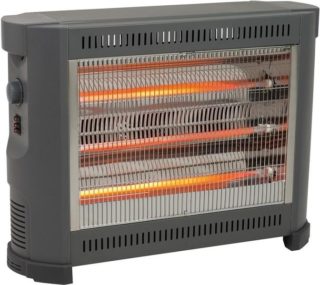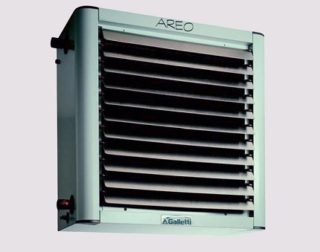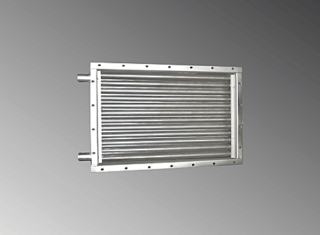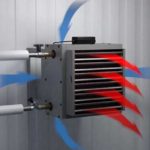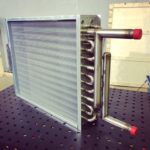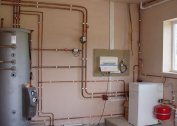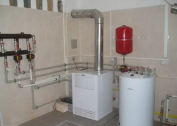The minus of centralized heating mains is the slow heating of radiators. The process of forcing a comfortable temperature can be accelerated with the help of a water fan heater. A water heater for heating is connected to the system, collects heat flows and distributes them around the room. Before installing the equipment, you need to understand the features of its work, varieties and installation procedure.
Application Specifics and Design
The fan heater is suitable for rooms from 150 m2, but can also be used in everyday life to enhance the capabilities of radiators. The device is also mounted in large spaces without batteries. The optimal location of the water heater is supply-type ventilation, because the input stream will be heated.
The supply air can be heated for heating and heat preservation purposes. Water models also prevent condensation from forming on the air vents. Currently, heating heaters, which consist of such elements, are popular:
- Heating unit. The main part of the construction is a steel tube with aluminum fins. The outer diameter of the nozzle is 37 mm, without ribs - 16 mm, intercostal distance - 2.8 mm. The protruding parts give off heat, retain it even with an intensive blowing mode.
- Handsets. They are arranged in the form of 2, 3 or 4 rows in a flat rectangular frame. Air masses are supplied by an axial or radial fan.
- Jalousie. Moved to the front, provide direction of flows working for heating.
- Electric motor Provides fan performance. With a heating power of 115 kW, an electric motor can have a power of 0.5 to 1 kW.
- Housing with mounting holes. It is made of steel with a corrosion-resistant surface or plastic.
Air heaters are designed for a maximum coolant temperature of 200 degrees and a pressure of maximum 1.2 kPa.
Classification of tube heaters
Devices are equipped with tubes directed across the movement of air. To eliminate the risks of airing, water is directed through the pipes from the bottom up. The connecting flanges at the ends of the housing have openings located under the connections to the ventilation ducts. Depending on the shape of the tubes, there are several modifications of air heaters.
Smooth pipe
Heaters are made of hollow pipes 20-32 mm in diameter, located at a distance of 0.5 cm from each other. The heater can be selected by the location of the tubes in the water heater:
- Corridor. The ends of the elements are welded into the upper and lower manifold. Water through the inlet pipe is sent to the distribution box. It moves through the pipes and heats them, being discharged in the form of condensate or chilled liquid.
- Chess. Differs in high resistance to air streams. The heater works normally when the dustiness of the air is less than 0.5 mg / mᶾ and the inlet water temperature is +20 degrees.
Smooth tube devices are suitable for low air consumption.
Lamellar
Modifications with fins that increase heat transfer. The plates are rectangular and round. Elements are equipped with tubes on which a corrugated tape made of steel 1 cm wide and 0.4 mm thick is wound.
The medium-sized model is a three-row version, and the larger is available with 4 rows of pipes.The dimensions of the plates of medium variation with a thickness of 0.5 mm - 11.7 x 13.6 cm. Large differ from them only in length - 17.5 mm. Large plates are arranged in a zigzag pattern, and medium ones in the form of a corridor.
The type of heater for plate heaters can be identified by marking. The SDT4009B models are compatible with steam and are installed vertically. The STD3010G air heater can be connected horizontally to the system with water.
Bimetallic
A device with a spiral-rolled fin, suitable for an aqueous heat transfer medium with a maximum temperature of 180 degrees. Bimetallic air heaters of the KSK3 and KPZ series are average in size and are equipped with 3 rows of tubes. Large devices such as KSK4 and KP4 have 4 rows of nozzles.
The similarity of KSK of both types lies in the design. They consist of heat exchangers, side shields, tubular grilles and covers with partitions. Heat exchangers are made in the form of 2 tubes. The inner 1.6 cm in diameter is made of steel with aluminum outer fins. The transverse distance between the nozzles is 4.15 cm, the longitudinal is 3.6 cm.
Varieties by installation method
Depending on the design of the housing, you can choose a fan heater:
- Floor type. Installed without fasteners, quickly connected to the water supply. Mobile models are easy to carry to a new place.
- Wall type. The wall heater is equipped with a mounting console for adjusting the vertical position. The element is fastened with anchor bolts, after which the water circuit is connected.
Household appliances - single-circuit, connected only to hot or cold water supply.
- Wall
- Floor
Operating conditions and features
The principle of operation of a water heater for heating, equipped with a fan, is based on the heat exchange of two working environments. Hot water is used as the primary coolant, and air is used as the secondary coolant. Heated air masses are carried out by transferring the heat of hot water to a cold air stream. The heat transfer efficiency depends on the temperature difference - it must be large.
When operating devices, several requirements must be observed:
- Before installation in a large room, performance indicators are calculated.
- Household models are compact, compatible with steam or water heating.
- The use of water with a temperature of more than 180 degrees in the highways is unacceptable - the air heater will fail.
- For large rooms, the heater power control system is used in the form of a mixer with a three- or two-way valve type.
- The maximum density of aggressive impurities in the air during operation of the device is specified in GN 2.2.5.686-98 and GOST 12.1.007-76.
- The energy efficiency of the heater depends on the heat transfer coefficient. The value is indicated in the passport.
- Before installation in a home workshop or garage, it is required to install filters to remove chemical impurities.
- Three-row models are suitable for ventilation communications, which supply outdoor air at temperatures from 0 to -40 degrees.
- Four-row modifications are launched in winter only at a speed of increasing the temperature regime up to 30 degrees per hour.
- Units are not suitable for forced or artificial ventilation - they pump air duct elements.
The maximum low temperature at which the air heater will work is -25 degrees.
Pros and cons of a heating water heater
The advantages of water heaters include:
- simple installation in comparison with communications where there is a radiator;
- efficiency and heating rate;
- productivity - a heater can heat a country house or a production area;
- operational safety;
- automatic shutdown and inclusion of heating at models with temperature sensors;
- smooth adjustment and adjustment of operating modes;
- compatibility with the central system or local networks - boilers;
- silent operation;
- lack of load on the electric line.
Calorifer equipment has several drawbacks:
- dependent on the availability of water in the highways;
- the coolant must be brought to the device mounting area;
- complexity of maintenance;
- stopping the heat supply if the fan stops.
Despite several disadvantages, water heaters are characterized by heating efficiency and economical water consumption.
Installation tips
A water heater is installed in rooms connected to the central heating main. With self-assembly, it is worth following the recommendations of specialists:
- The diagonal of the heater depends on the characteristics of the bends of the channels, the type of damper and structural elements.
- To protect the heater from freezing, the installation is carried out in rooms with a temperature of at least 0 degrees.
- Before starting the installation, it is necessary to inspect the plates and tubes for integrity.
- Butt weld flanges are the easiest to weld.
- The straight-through valves of the air vents are located at the top of the outlet and supply manifolds.
- The joints of the device and ventilation system are sealed.
- Wall-mounted models are installed by fixing the console with two screws.
In the absence of experience in connecting and tying up the work system, it is better to entrust it to specialists.
The specifics of using water heaters for heating
Water-type fan heaters are used for heating rooms with a large area - shops or offices. They allow you to quickly dry carpets or car seats, so they can be used in car washes and dry cleaners.
Water heat sources are justified for basement floors with high levels of humidity. They are allowed to be installed in garages, construction cars, workshops, on the territory of warehouses or workshops for the manufacture of polymers.
Ducted water heaters are suitable for maintaining a comfortable temperature in the house and in the workplace. Energy-saving equipment practically does not consume electricity and gas, which saves on utility bills.

